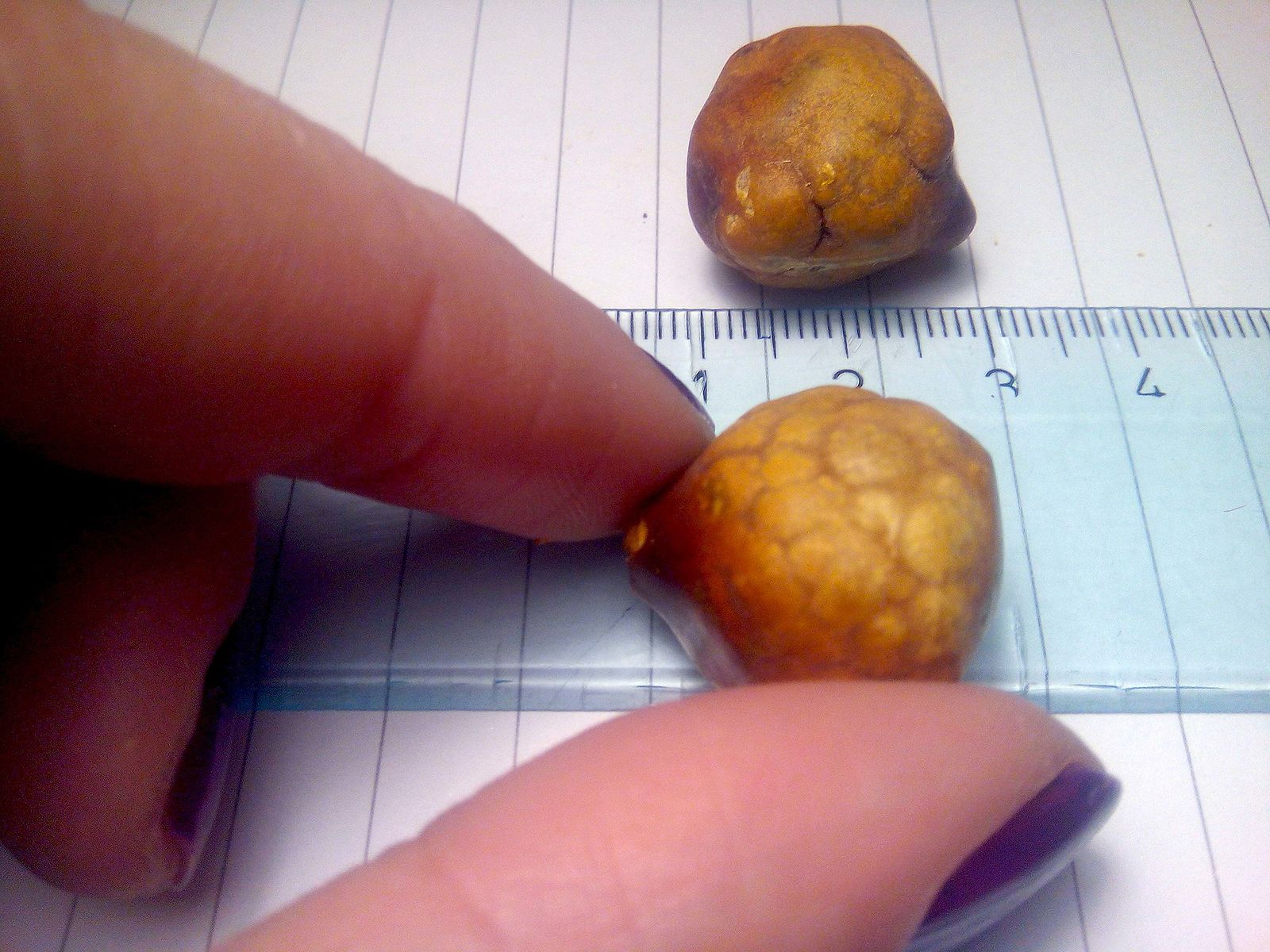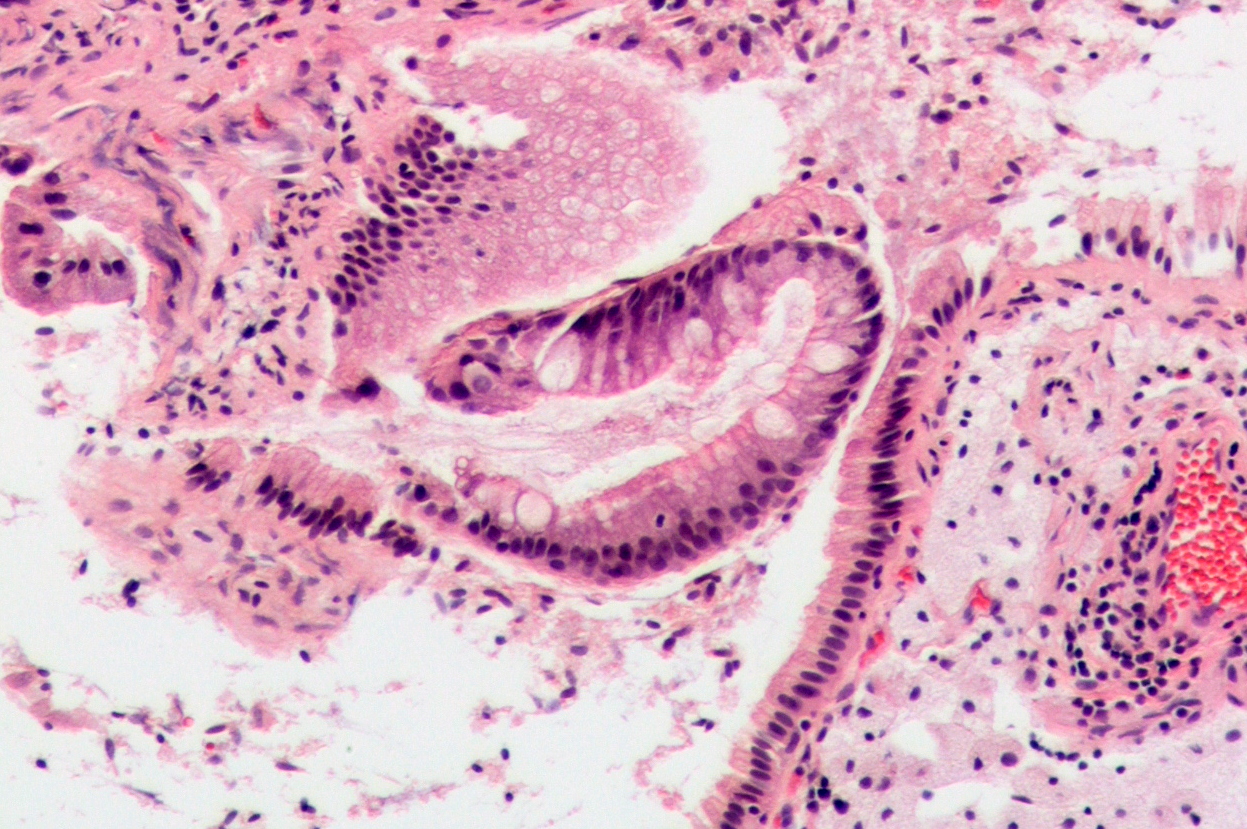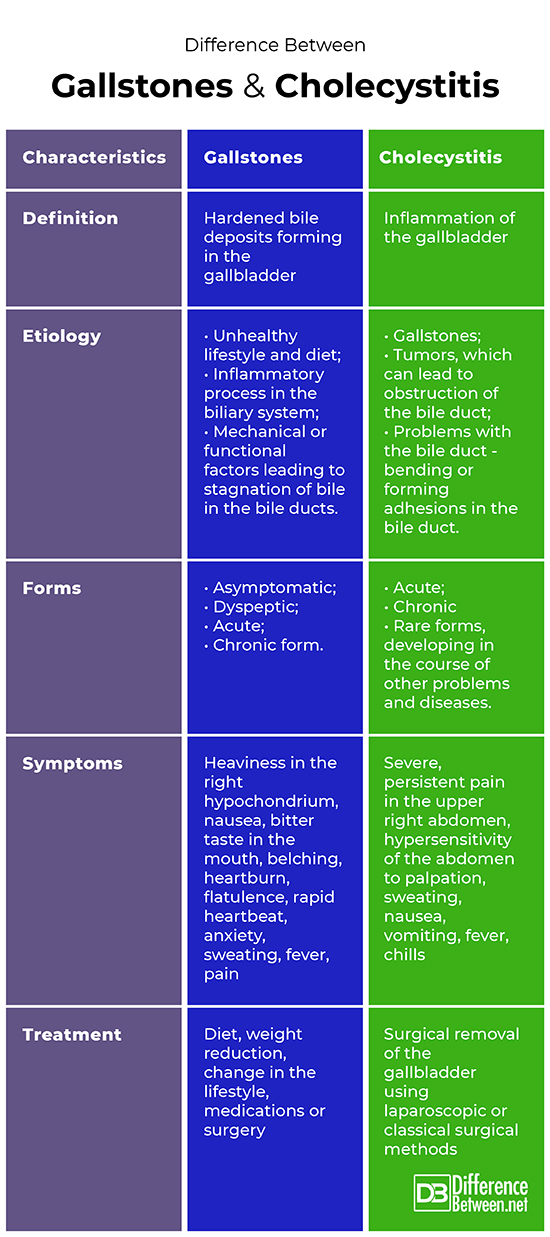Difference Between Gallstones and Cholecystitis
The gallbladder is a small organ located below the liver. Fluid called bile, produced by the liver, is stored in the gallbladder. From the gallbladder, bile enters the small intestine through the bile duct and there comes into contact with food and plays a role in the process of digesting fat. The most common gallbladder health problems include gallstones and cholecystitis. They may or may not be related to each other – gallstones can occur with or without causing cholecystitis, and cholecystitis may result from gallstones or other factors.

What is Gallstones?
Gallstones are hardened bile deposits that can form in the gallbladder. Bile is the yellow-greenish fluid, consisting of cholesterol, waste products, and bile salts. It is secreted by the liver and its functions are to break down fats during digestion and carry away waste products.
People may develop one or more gallstones at the same time. They vary from as small as a grain of sand to as large as a golf ball. Gallstones are often a result of an unhealthy way of life and diet and are more common in people who are prone to overeating and lead a sedentary lifestyle. It is also possible for gallstones to be formed as a result of an inflammatory process in the biliary system. Desquamation (peeling) of the epithelium as a result of the inflammation creates a nucleus for the initial grouping of salts. Gallstones may also be a result of mechanical (spiral form of ductus cysticus, adhesions and folds of the bile ducts) or functional (persistent spasm of the sphincters, duodenostasis, and impaired motility of the gallbladder) factors leading to stagnation of bile in the bile ducts and thus creating prerequisites for abnormal concentration and crystallization of its components.
Gallstones show a higher incidence in females. Their formation may be facilitated as a result of hormonal changes (pregnancy, birth, menopause, hormone replacement therapy with estrogen).
The symptoms vary depending on disease duration, size, number and location of gallstones, age and health status of the patient, accompanying diseases, etc.
The condition has four forms:
- Asymptomatic form – there are no symptoms, the gallstones are found accidentally by ultrasound or X-ray examination;
- Dyspeptic form – there is heaviness in the right hypochondrium, increasing after eating foods that cause strong contraction of the gallbladder(fatty and spicy foods, eggs, chocolate, coffee, etc.), nausea, bitter taste in the mouth, belching, heartburn, flatulence;
- Acute form – the pain is caused by a temporary obstruction or the passage of a stone through the ductus cysticus. It is provoked by excessive eating of foods that cause strong contraction of the gallbladder. There may be nausea and vomiting, rapid heartbeat, anxiety, sweating, fever;
- Chronic form – occurs without well-defined pain attacks. In some cases, there is a constant moderate pain in the right hypochondrium.
Diagnosis is made by the following diagnostic methods:
- Medical history;
- Examination of the patient;
- Laboratory data – changes in white blood cell counts, elevated levels of liver enzymes and bilirubin, abnormalities in the lipid profile, etc.;
- Instrumental and imaging methods – radiography, ultrasound, computed tomography, magnetic resonance imaging, hepatobiliary scintigraphy, endoscopy.
The treatment depends on the type of gallstones, the clinical picture, complications, general condition and age of the patient, and may include:
- Diet and weight reduction;
- Change in the lifestyle – limit overeating, consumption of harmful foods, alcohol, carbonated and caffeinated drinks;
- Medications – chenodeoxycholic and/or ursodeoxycholic acid, analgesics, antispasmodics;
- Surgery – removal of stones or removal of the entire gallbladder.

What is Cholecystitis?
Cholecystitis is an inflammation of the gallbladder. The most common causes leading to this condition are:
- Gallstones – they can clog the duct, through which bile reaches the small intestine, and lead to bile retention and inflammation;
- Tumor – it can lead to obstruction of the bile duct and disruption of normal bile flow;
- Other problems with the bile duct – bending or forming adhesions in the bile duct can disrupt the movement of bile and cause cholecystitis.
The most common cause of cholecystitis is gallstones. However many people have gallstones for years without significant complaints and without cholecystitis.
Women are more prone to gallstone formation than men, which increases their risk of developing cholecystitis. With age, there are changes in the digestive system, which predispose to the formation of gallstones and the development of cholecystitis.
The most common symptoms of cholecystitis are:
- Severe, persistent pain in the upper right abdomen (just below the right costal arch);
- Pain that radiates from the abdomen to the right shoulder and to the back;
- Hypersensitivity of the abdomen to palpation;
- Sweating;
- Nausea and vomiting;
- Fever;
- Chills.
The symptoms of cholecystitis usually occur after a hearty meal, especially with fatty foods.
In general, the following main forms of cholecystitis are distinguished:
- Acute – occurs with severe and sudden pain, accompanied by severe nausea, vomiting, and fever;
- Chronic – periodic, moderate pain and heaviness in the right hypochondrium and epigastrium. It occurs with periods of exacerbation and remission;
- Other types – rare forms of the disease that usually develop secondarily, in the course of other problems of the gastrointestinal tract or in the course of diseases of a systemic nature.
Diagnosis is based on data from medical history and physical examination, as well as laboratory tests and information obtained from imaging studies – radiography, ultrasound, computed tomography, magnetic resonance imaging, hepatobiliary scintigraphy, and endoscopy. Laboratory tests include a complete blood count and a differential blood count, liver enzymes, bilirubin (total and direct), etc.
Cholecystitis can lead to serious complications, including:
- Enlarged gallbladder, accompanied by pain and an increased risk of rupture;
- Gallbladder gangrene, most often followed by a rupture;
- Peritonitis, resulting from rupture or gangrene.
Surgical removal of the gallbladder using laparoscopic or classical surgical methods is the only definitive and permanent treatment of acute cholecystitis. In chronic forms of cholecystitis, surgery may be delayed until complete stabilization of the patient’s condition. Appropriate preoperative and postoperative care and monitoring of patients are recommended for the optimization of surgical treatment.
Difference Between Gallstones and Cholecystitis
Definition
Gallstones: Gallstones are hardened bile deposits that can form in the gallbladder.
Cholecystitis: Cholecystitisis an inflammation of the gallbladder.
Etiology
Gallstones: Gallstones can be a result of an unhealthy lifestyle and diet, inflammatory process in the biliary system, mechanical or functional factors leading to stagnation of bile in the bile ducts.
Cholecystitis: The most common cause of cholecystitis is gallstones. Other causes include tumors, which can lead to obstruction of the bile duct and disruption of normal bile flow and problems with the bile duct – bending or forming adhesions in the bile duct.
Forms
Gallstones: The main forms of gallstones are asymptomatic, dyspeptic, acute, and chronic.
Cholecystitis: The main forms of cholecystitis are acute, chronic, and other rare forms, which usually develop secondarily, in the course of other problems and diseases.
Symptoms
Gallstones: Depending on the form symptoms may include heaviness in the right hypochondrium, nausea, bitter taste in the mouth, belching, heartburn, flatulence, rapid heartbeat, anxiety, sweating, fever, pain.
Cholecystitis: The most common symptoms of cholecystitis are severe, persistent pain in the upper right abdomen, hypersensitivity of the abdomen to palpation, sweating, nausea, vomiting, fever, chills.
Treatment
Gallstones: The treatment depends on the type of gallstones, the clinical picture, complications, general condition and age of the patient, and may include diet, weight reduction, change in the lifestyle, medications or surgery.
Cholecystitis: Surgical removal of the gallbladder using laparoscopic or classical surgical methods is the only definitive and permanent treatment of cholecystitis.
Difference Between Gallstones and Cholecystitis

Summary:
- The gallbladder is a small organ located below the liver. A fluid called bile, produced by the liver, is stored in it.
- The most common gallbladder health problems include gallstones and cholecystitis. They show a higher incidence in females.
- Gallstones are hardened bile deposits that can form in the gallbladder.
- Cholecystitis is an inflammation of the gallbladder.
- Gallstones can occur with or without causing cholecystitis, and cholecystitis may result from gallstones or other factors.
- Gallstones can be a result of an unhealthy lifestyle and diet, inflammatory process in the biliary system, mechanical or functional factors leading to stagnation of bile in the bile ducts. The most common cause of cholecystitis is gallstones. Other causes include tumors, which can lead to obstruction of the bile duct and disruption of normal bile flow and problems with the bile duct – bending or forming adhesions in the bile duct.
- The main forms of gallstones are asymptomatic, dyspeptic, acute, and chronic. The main forms of cholecystitis are acute, chronic, and other rare forms, which usually develop secondarily.
- Symptoms of gallstones may include heaviness in the right hypochondrium, nausea, bitter taste in the mouth, belching, heartburn, flatulence, rapid heartbeat, anxiety, sweating, fever, pain. The most common symptoms of cholecystitis are severe, persistent pain in the upper right abdomen, hypersensitivity of the abdomen to palpation, sweating, nausea, vomiting, fever, chills.
- Diagnosis of both gallstones and cholecystitis is made based on medical history, examination of the patient, laboratory data, instrumental and imaging methods.
- The treatment of gallstones may include diet, weight reduction, medications or surgery. Surgical removal of the gallbladder using laparoscopic or classical surgical methods is the only definitive and permanent treatment of cholecystitis.
- Difference Between Gallstones and Cholecystitis - September 5, 2021
- Difference Between Constipation and Cramping - August 4, 2021
- Difference Between Whole Genome Sequencing and Microarray - May 6, 2021
Search DifferenceBetween.net :
Leave a Response
References :
[0]Shah, M. Gallbladder Diet: A Complete Diet Guide for People with Gallbladder Disorders. Scotts Valley: CreteSpace LLC. 2017. Print.
[1]Swobodnik, W., R. Soloway, H. Ditschuneit (Eds.). Gallstone Disease. Pathophysiology and Therapeutic Approaches. Berlin: Springer. 1990. Print.
[2]Warrell, D., T. Cox, J. Firth. Oxford Textbook of Medicine. Oxford: Oxford University Press. 2010. Print.
[3]Image credit: https://commons.wikimedia.org/wiki/File:Chronic_cholecystitis_with_cholesterolosis_and_intestinal_metaplasia.JPG
[4]Image credit: https://commons.wikimedia.org/wiki/File:%D0%96%D0%BE%D0%BB%D1%87%D0%BD%D0%B8_%D0%BA%D0%B0%D0%BC%D0%B5%D1%9A%D0%B0,Gallstones!!.jpg
